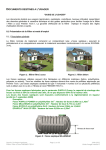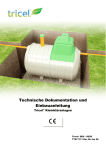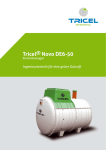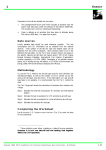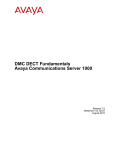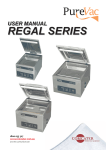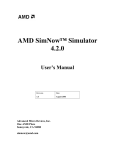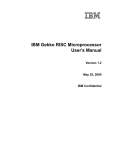Download Operation & Maintenance Including User Guide
Transcript
Operation & Maintenance Including User Guide Diamond Sewage Treatment DMS and DMS-IPC DMC Please note - WPL Offers clear instructions on using and maintaining its treatment plants. Consent holders and/or treatment plant users are responsible for correctly operating and maintaining their plant as per the manufacturer’s instructions. Sewage Treatment Plants Environmental Wastewater Solutions www.wpl.co.uk Thank you for choosing the WPL Limited Diamond domestic wastewater treatment system. SERVICING AND MAINTENANCE Since April 2010, the Environment Agency Environmental Permitting Programme (EPP2) requires that all sewage treatment plants are operated and maintained in accordance with the manufacturer’s instructions, and that the maintenance log is recorded and retained for at least 5 years under the Environmental Permitting Programme EPP2. In order to sustain the high performance of your Diamond plant, this User Guide/ Operation & Maintenance Manual sets out the required periodic maintenance and operating instructions. WPL supplies a separate Maintenance Log Book with each Diamond, which is designed to record the regular six monthly maintenance cycle for your sewage treatment plant. The WPL Diamond has been designed for simple tank and blower maintenance and WPL Ltd recommends this maintenance is carried out by a British Water Accredited, Qualified Service Engineer. It is also important that wastewater sludge from the sewage treatment plant is safely disposed of in an appropriate or controlled manner at the recommended intervals. De-sludging MUST be carried out by an approved tankering company and WPL recommends that de-sludging is arranged with a reputable company in your area. We recommend that you keep this manual, along with your log book, in a safe place on the premises where the Diamond is installed for easy reference. Replacement Maintenance Log Books and User Guide/Operation and Maintenance Manuals are available by calling WPL Limited on 023 9224 2600. WPL LIMITED SPARE PARTS Please contact the WPL Spares Department on 023 9224 2600 for prices and information. The Diamond is CE marked, fully type tested and certificated in accordance with the mandatory European standard BS EN125663, and meets all current legislation under the Environmental Permitting Programme. WPL Diamond is also LABC registered. 2 INDEX 1. GETTING THE BEST FROM YOUR DIAMOND 1.1 Important informationpage 4 1.2 Hints and Tipspage 5 1.3 Recommendationspage 6 1.4 Letting Visitors Know page 7 2. HOW THE DIAMOND WORKS 2.1 Operating Conditionspage 8 2.2 Inside the Diamond Plant page 8 2.3 The Treatment Process page 8 2.4 Schematic Diagrampage 9 3. MAINTENANCE 3.1 Health & Safety page 10 3.1.1 Warning 3.1.2 Dangerous Gases 3.2 Routine Maintenancepage 10 3.2.1 Weekly 3.2.2 Quarterly 3.2.3 Six-Monthly 3.3 Air Blower Information page 11 3.3.1 For DMS/DMS-IPC Models 3.3.2 For DMC Models 3.4 De-sludging page 11 3.4.1 De-sludging Frequency 3.4.2 Determining De-sludging Frequency 3.4.3 Procedure for De-sludging 3.4.4 Approximate De-sludging Volumes 4. TROUBLE SHOOTING AND PROBLEM SOLVING 4.1 DMS/DMC Modelspage 13 4.2 DMS-IPC Modelspage 14 5. GUARANTEE AND WARRANTY INFORMATION 5.1 Process Guaranteepage 15 5.2 Warranty Periodpage 15 5.3 Parts Covered Under Warranty page 15 5.4 Warranty Limitations/Exemptions page 15 5.5 Chargeable Non-Warranty Work page 15 3 1. GETTING THE BEST FROM YOUR DIAMOND 1.1 Important Information The following key points should have been taken into consideration when the plant was specified and sized using the latest version of the British Water Flows and Loads. To maintain efficient performance of the Diamond plant, the following should be noted and also considered if there are any changes to the property in the future: WASTE DISPOSAL UNITS (WDU) – The Diamond plant should have been sized taking into account the use of a WDU in the property (if there is one installed) as it increases biological loading. ADVICE – It is advisable to limit the use of the WDU to ensure the plant operates efficiently. Raw or uncooked foods should not be put through the WDU and ideally disposed of in a composter. If the use of a WDU was not included in the sizing of the plant then it is advised that the WDU is not used or installed subsequently in the property. WATER SOFTENERS – The Diamond plant should never be connected to a property using a water softener as the salt will significantly reduce the performance of the plant. ADVICE – Never use a Water Softener with a Diamond plant. If the use of a Water Softener is present in the property then it is advised that the Water Softener is disconnected. The use of a Magnetic or Electric Scale Reducer may be an alternative to a Water Softener as long as it does not use salt or chemicals but homeowners are advised to seek the advice of a specialist. SURFACE RUN-OFF/STORMWATER – The Diamond plant should never be connected to guttering and drainage collecting stormwater and/or surface water run-off from hard standings and surfaces. ADVICE – Surface/stormwater should always be discharged to a storm drain which is excluded from the wastewater stream from the property. LAUNDRY – The Diamond plant should have been sized taking into account the actual laundry carried out at the property as the laundry detergents/chemicals effect the performance of the plant. ADVICE – Changes to the amount of laundry or the type/number of washing machines in use may affect the performance of the plant. Contact WPL for advice if there are any changes planned. SWIMMING POOLS/HOT TUBS – The Diamond plant should never be connected to swimming pools, hot tubs etc. as they will contain chlorine which will significantly reduce the performance of the plant. ADVICE – Consider separate treatment or disposal of backwash waters from ancillary equipment such as types or filtration and disinfectant removal in pools and hot tubs. GREASE FROM KITCHENS – The Diamond plant should be protected from grease and fats if installed in a property or commercial premises where catering is provided. ADVICE – All commercial catering applications require the installation of adequately sized grease separators, removal or retention systems up-stream of the Diamond plant and it is advisable to check that this provision has been made prior to installing the Diamond plant. CONDENSING BOILERS – Discharge from condensing boilers . ADVICE - Should ideally be connected to a soakaway if possible. 4 1. GETTING THE BEST FROM YOUR DIAMOND (continued) 1.2 Hints and Tips The Diamond requires minimal servicing, provided it is installed as per the instructions in the WPL Ltd Installation Manual, and is used and maintained properly as set out in this User Guide/Operation and Maintenance Manual. Regular but simple maintenance will keep the system running efficiently and will reduce the number and cost of unnecessary service call-outs. DO aEnsure all servicing is carried out by a British Water Accredited, Qualified Service Engineer. aMake sure the air blower is installed in a dry, well ventilated area. If it is situated outside, ensure it is installed in the approved weatherproof housing supplied with the Diamond. aCheck the access lid is properly and securely fastened at all times. aMake sure the electrical supply is maintained at all times. aRegularly check to make sure the air blower is operating, you should be able to hear it running. aArrange for regular maintenance to be carried out, (see section 3 in this manual), and that it is recorded in the separate Maintenance Log Book provided by WPL. aArrange for the excess sludge to be tankered away at the appropriate interval. DO NOT X Turn off the electricity supply. X Attempt to service the system yourself if you are not qualified to do so. X Use any replacement parts other than those supplied by WPL Limited. X Alter or modify the system without authorisation from WPL Limited. X Allow surface water to form a pool around the access lid or blower housing. X Allow storm water from roofs or hard standings to enter the treatment plant. 5 1. GETTING THE BEST FROM YOUR DIAMOND (continued) 1.3 Recommendations The Diamond system uses highly efficient aerobic organisms to treat the organic contaminants in domestic sewage and wastewater. As the system is based on a biological process it is important to ensure that you do not put anything down the sink, toilet or drains that will harm these organisms which bio-degrade the sewage. The way you use cleaning products, and the type you use, can also significantly affect the efficiency of the system. WPL DOES RECOMMEND aThinking before you put anything down the sink, toilet or drains. aUsing the manufacturers’ recommended doses relevant to the hardness of your local water for household cleaning products. aUsing cleaning products little and often, as this will allow the bacteria to become accustomed to the brands and amounts you use. aSpreading your laundry throughout the week and overnight. aSticking to the same washing, dishwasher and other cleaning products as the organisms will work more efficiently with familiar products. aUsing liquids, not powders, in washing machines and dishwashers as they dissolve more easily. WPL DOES NOT RECOMMEND X Putting sanitary towels, tampons, disposable nappies, baby wipes, cotton wool, incontinence pads, cotton buds, rubber products or other non-biodegradable products down the toilet. X Pouring waste fat, grease or cooking oil down the sink or drains. X Using bleach or strong chemicals excessively or having a spring cleaning day. X Having a laundry day. X Emptying bottles of medicine or mouth wash down the toilet or sink. X Constantly changing your brands of cleaners and washing chemicals. X Using water softening agents. X Pouring any garden chemicals, paint or car engine oil down the drain or sink. X Over using your waste disposal unit, please use it sparingly. 6 1. GETTING THE BEST FROM YOUR DIAMOND (continued) 1.4 Letting Visitors Know It is important that your family, guests and visitors are made aware that your house is connected to a specialist, biological sewage treatment system. They need to know that they should not put anything down the toilet, sinks or drains which could harm the bacteria or block the system. The easiest way to tell guests or visitors that you have a specialist biological sewage treatment system is to put up notices in your kitchen and bathroom(s). You might like to copy this suggested wording: WARNING! This toilet is not connected to mains drainage. It leads to a biological sewage & wastewater treatment system. DO NOT PUT THE FOLLOWING DOWN THE TOILET: ANYTHING OTHER THAN TOILET TISSUE EXCESSIVE AMOUNTS OF CHEMICAL CLEANERS/BLEACH WARNING! This sink is not connected to mains drainage. It leads to a biological sewage & wastewater treatment system. DO NOT PUT THE FOLLOWING DOWN THE SINK: FAT, OIL OR GREASE EXCESSIVE AMOUNTS OF CHEMICALS 7 2. HOW THE DIAMOND WORKS 2.1 Operating Conditions The plant is designed to operate automatically with the minimum of maintenance after it has been commissioned. The plant will provide effluent within the designed discharge consent standard after an initial start up period of 4-10 weeks, depending on the water temperature. It is important that the sewage input conditions are kept within the plant design criteria, including the population equivalent (as set by British Water). 2.2 Inside the Diamond The Diamond system consists of two treatment chambers in a single tank. The central aeration chamber is a circular tank with a sloped, open bottom which empties into the bottom of the outer clarifier chamber. Located in the centre of the aeration chamber is a circular draft tube, which extends towards the bottom of the clarifier. 2.3 The Treatment Process Air is released at the bottom of the draft tube through a disc plate diffuser and as the diffused air rises in the draft tube, it causes an upward flow of process fluid. This draws the settled solids from the bottom of the clarifier up through the draft tube where they are discharged at the surface of the aeration chamber. The design of the draft tube ensures continuous and complete mixing of oxygen with the sewage, allowing for the growth of various aerobic organisms that biologically degrade the wastewater contaminants. Gravity causes the aerated solids to settle back to the bottom of the tank where they are again drawn back up through the draft tube. As raw sewage enters the aeration chamber it displaces biological solids from the aeration chamber to the clarifier. Quiescent conditions in the clarifier allow the digested solids to settle to the bottom of the clarifier where they are again returned back to the aeration compartment. The clarified (treated) effluent flows slowly up through the clarifier and over a weir that extends around the periphery of the tank. The effluent collects in an outer trough where it discharges through a 110mm-pipe connection. A scum baffle, located inside the overflow weir, prevents floating solids from passing over the weir. 8 2. HOW THE DIAMOND WORKS (continued) 2.4 Schematic diagram The diagram opposite shows the exploded section for Diamond DMS-IPC models, which have an integral pump chamber. 9 3. MAINTENANCE 3.1 Health and Safety 3.1.1 Health Warning - There are significant Health and Safety risks associated with the servicing and maintenance of any sewage treatment plant. WPL Ltd recommends that servicing and maintenance is carried out by British Water Accredited, Qualified Service Engineers. Please contact WPL Ltd on 023 9224 2600 for any further Health and Safety advice. 3.1.2 Dangerous Gases - Sewage gases are potentially explosive and toxic. DO NOT enter any of the below ground compartments of the Diamond sewage treatment plant. 3.2 Routine Maintenance The Diamond plant requires routine, periodic inspection and maintenance to ensure continuous, trouble-free operation. At a minimum, the Diamond should be inspected every six months (see separate log book for details) by a British Water Accredited, Qualified Service Engineer. More frequent inspections may be required if mandated by local or stated regulatory authorities, or if the Diamond is used on a non-residential application. 3.2.1 Weekly - Check that the air blower is operational. The motor should be running, which you can hear externally, and the air failure beacon should NOT be flashing. The beacon indicates that the air pump auto stopper has activated, not power failure. 3.2.2 Quarterly - (If required by prevailing temperature, dust and humidity conditions.) Check air blower filter cleanliness and clean or replace the filter as necessary. Air blower instructions are supplied in the air blower packaging. 3.2.3 Six-Monthly - The air blower (DMC blades) and kiosk, aeration chamber, air diffuser system, clarifying chamber, integral pump chamber (depending on model), outlet weir and sample chamber (if applicable) all need to be checked and maintained as necessary. 10 3. MAINTENANCE (continued) 3.3 Air Blower Information 3.3.1 DMS/DMS-IPC Models - Each DMS system is supplied with a linear air blower covered by a comprehensive 24 month warranty, subject to the correct maintenance procedures being adhered to (see section 5.4, page 12 for warranty limitations). Each DMS system blower must be maintained in accordance with the Manufacturer’s instructions. Please refer to the specific instruction manual supplied in the air blower packaging and the WPL Maintenance Log Book. Service kits/spares can be obtained from WPL Limited on 023 9224 2600. Please note - DMS Air blowers should only be allowed to draw-in clean uncontaminated ambient air • Intake filter shall be inspected/cleaned or replaced every 6 months • Installation of a service kit (New valve boxes, diaphragms, filter element) every 18 months • Operating pressure shall not be more than 200mbar • Ambient air temperature should not exceed 38ºC +10% The maintenance programme 3-5 years is as follows: • From 36-42 months - Replace filter, diaphragm kit and valve box • From 48-54 months - Replace filter and diaphragm kit For DMS-IPC Model with Integral Pump Chamber, please ensure the operation and cleanliness of the integral pump chamber is checked during servicing (see log book for section on integral pump chamber maintenance). 3.3.2 DMC Models - Each DMC System is supplied with a rotary vaned air blower covered by a comprehensive 24 month warranty, subject to the correct maintenance procedures being adhered to (see section 5.4, page15 for warranty limitations). Please refer to the specific instruction manual supplied in the air blower packaging. Spares can be obtained from WPL Limited on 023 9224 2600. 3.4 De-sludging 3.4.1 De-sludging Frequency - The rate at which the solids (biomass) accumulate in the Diamond, and subsequently the rate at which the excess solids must be removed, is dependant upon the total volume and strength of the wastewater entering the plant. 11 3. MAINTENANCE (continued) 3.4 De-sludging (continued) 3.4.1 De-sludging frequency (continued) Diamond DMS/DMS-IPC systems serving domestic residential properties typically require de-sludging every 36 to 60 months. Diamond DMC systems serving domestic residential properties will typically require de-sludging every 12 months. In some circumstances plants may need more frequent de-sludging. 3.4.2 Determining De-sludging Frequency - This should be provided by a British Water Accredited, Qualified Service Engineer who will check the percentage of settled sludge (i.e. sludge volume) to the clear liquor. The optimum level of solid settlement is normally between 5-50%. Whenever the sludge volume reaches 70%, the plant should be de-sludged. 3.4.3 Procedure for De-sludging the Diamond - De-sludging MUST be carried out by an approved tankering company. WPL recommends that de-sludging is arranged with a reputable company in your area. When de-sludging is carried out, approximately one third of the volume of sludge should remain in the plant. 3.4.4 Approximate De-Sludge Volumes - This table is a guide only. The amount of sludge accumulated depends on the loading of the plant. Each site has its own characteristics. 12 MODEL App. De-sludge Volumes (ltrs) DMS2 1500 DMS3 2100 DMS4 2650 DMS5 2650 DMC6 6000 DMC7 6000 DMC8 10000 DMC9 10000 4. TROUBLESHOOTING AND PROBLEM SOLVING 4.1 DMS/DMC Models A - SYMPTOM 1. Air blower is running but little or no turbulence is observed in aeration chamber B - CAUSE C - REMEDIAL ACTION 1. Blocked air diffuser 1. Disconnect air pipe at the union and clean or replace air diffuser 2. Blocked air hose or pipe 2. Inspect hose and pipe for blockages, especially at joints. Unblock as necessary 3. Leaking hose or pipe joints 3. Inspect all hose and pipe joints and tighten as necessary 4. Kinked, crushed or split air hose or pipe 4. Inspect and replace as necessary 5. Excessively worn carbon vanes in Rotary Vaned Air Pump (DMC only) 5. See specific air blower manual 2. Aeration chamber contents have a greyish (dishwater) appearance 6. As B 1-4 6. As C 1-5 3. Noticeable odour & poor effluent quality 7. As B 1-4 7. As C 1-5 This could be due to insufficient air supply to the aeration chamber, caused by one or more of the reasons opposite: 4. Aeration chamber 8. Heavy hydraulic surge contents are grey/brown flows from laundry or to black. Slight to strong kitchen activities septic odour. Effluent quality is poor and is grey. Air blower is running and good turbulence is evident 8. For commercial applications, install a surge tank before the Diamond 5. Aeration chamber has a clear appearance with very few suspended solids (<5%). White suds observed. Effluent is clear with no odour 9. Light loading resulting in total digestion of solids 10. No action required if effluent quality is acceptable. Typical of intermittent use. 6. Aeration chamber as 5, but with very fine particles in the effluent causing it to appear turbid or murky 10. See B 8 11. See C 8-9 7. Aeration chamber contents have a grey appearance and slightly septic odour 11. System is lightly loaded and has been in use for less than 3 months 12. Continue start-up regime of minimal laundry and minimal cleaning chemicals. 12. Insufficient organic matter present in the influent resulting in a slow start-up 14. “Seed” plant with WPL Formula 33 to help initiate startup 13. See B 8 15. See C 10 9. For residential applications, reduce the frequency of laundry to 1-2 loads per day 13. See C 1-5 13 4. TROUBLESHOOTING AND PROBLEM SOLVING (continued) 4.1 DMS/DMC Models (continued) A - SYMPTOM B - CAUSE C - REMEDIAL ACTION 8. Aeration chamber contents are grey to black. Effluent is grey and has a strong septic odour 14. Organic overload due to excessive use of waste disposal unit 16. Refrain from discharging food scraps, grease, oil, etc into the waste disposal 15. As B 1-4 17. As C 1-5 9. Grease balls are observed in the aeration chamber contents 16. Excessive laundry use 18. As C 8-9 17. As B 1-4 19. As C 1-4 18. Insufficient Dissolved Oxygen (DO) 20. At the time of a peak flow, turn air blower off for 15 minutes and check DO with a metre. If DO is less than 1.0 part per million, contact WPL for assistance 19. Heavy build up of mixed liquor suspended solids (MLSS), due to normal, long-term usage 21. De-sludge the Diamond 20. Excessive (>125mm) of scum has accumulated in the clarifying chamber. The scum is being carried under the scum baffle 22. Remove scum back to aeration chamber with a scoop 11. System requires de-sludging on a more frequent basis 21. Excessive use of powdered laundry detergent 23. Use liquid detergents or “concentrated” powders 12. Effluent sample contains excessive suspended solids. Aeration chamber contents have a normal chocolate brown colour, but sludge settles slowly in a jar and forms a light floc 22. Overabundance of “filamentous” bacteria that prevent compaction and settling of the sludge 24. Contact WPL for specific recommendations 13. Alarm beacon flashing 23. Blower motor tripped out probably cause diaphragm failure 25. Replace diaphragms 10. Effluent sample contains brown suspended solids, more noticeable during peak flow periods 4.2 DMS-IPC Models with integral pump A - SYMPTOM 1. No discharge B - CAUSE 1. No flow as pump not working C - REMEDIAL ACTION 1. Check power supply 2. Check operation of float 14 2. Beacon flashing 2. High level alarm 3. As C1-2 3. Plant overflowing 3. No power 4. Check power supply 5. GUARANTEE AND WARRANTY INFORMATION 5.1 Process guarantee The process is guaranteed to meet the designed Effluent Discharge Standard for the life of the plant provided that: • All aspects of the Installation Manual and User Guide Operation & Maintenance Manual are adhered to • The flows and loads do not exceed those stated on the design sheet (based on industry standard figures, ref. BW COP: 7/09) • There is sufficient hardness in the water where nitrification is required • Grease from commercial kitchens is not present in the influent • Performance is measured after the process has matured • Biological inhibitors are not present in the influent • The pH is 7 to 9 5.2 Warranty period The warranty period for Diamond DMS/DMC systems is 10 years on the tank for manufacturing defects and 2 years for the air blower, both from date of purchase (see points 5.3 and 5.4 below). 5.3 Parts covered under warranty WPL Ltd warrants all of the parts in each of their Diamond range of package sewage treatment systems, when properly registered with the manufacturer, to be free from defects in materials and workmanship in normal use and service. WPL Ltd’s sole responsibility under this warranty is limited to repairing, exchanging or replacing any component part or parts that in their judgement show evidence of defects within the warranty period. If you have a defective part please contact your maintenance provider. The defective part or parts must be returned to WPL Limited. 5.4 Warranty limitations/exemptions WPL Ltd shall not be liable for any labour involved for the removal or replacement of its equipment nor the subsequent transportation, handling or packaging of any part or parts thereof. In no case will WPL Ltd be liable for loss incurred because of interruption of service or for consequential damages, labour or expense required to repair defective units, nor shall this constitute a cause for the cancellation of the contract of purchase and sale. Specifically exempt from this warranty are limited life consumable components subject to normal wear and tear, such as air pump vanes, diaphragms and filters. 5.5 Chargeable non-warranty work Service charges incurred (including parts and labour), due to unauthorised alteration, accidental damage, improper use, abuse, tampering, failure to follow installation instructions or failure to follow operating and maintenance procedures, are not covered by this warranty and are not assumed by WPL Ltd. All service visits for non warranty work are chargeable. This warranty gives specific additional benefits. Statutory rights are unaffected. 15 WPL Limited Units 1 & 2 Aston Road Waterlooville Hampshire PO7 7UX United Kingdom Tel: +44 (0)23 9224 2600 Fax: +44 (0)23 9224 2624 email: [email protected] www.wpl.co.uk WPL has a policy of continuous product development and the information contained in this booklet may be subject to change without notice. Version EJ05MAR12
















